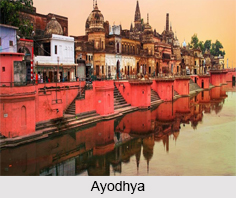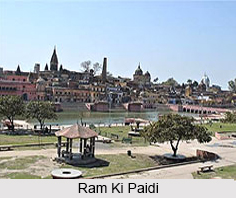 Ayodhya is an ancient city of India lying on the bank of Ghaghara River. This is situated on the east of Faizabad district of Uttar Pradesh. Ayodhya is considered as one of the seven sacred cities of the Hindus because of its association with Ramayana. Amongst the holy places of the Hindus, Ayodhya stands out pre-eminent.
Ayodhya is an ancient city of India lying on the bank of Ghaghara River. This is situated on the east of Faizabad district of Uttar Pradesh. Ayodhya is considered as one of the seven sacred cities of the Hindus because of its association with Ramayana. Amongst the holy places of the Hindus, Ayodhya stands out pre-eminent.
Etymology of Ayodhya
The word "Ayodhya" in Sanskrit means “not to be warred againstâ€. Ayodhya is regarded as the birthplace of Rama. Many Hindus believe Lord Rama was born at this place and thus it is called “Rama Janmabhoomiâ€. In the ancient times, Ayodhya was known as "Kosaldesa" and the region has been described as “a city built by Gods and being as prosperous as paradise itselfâ€.
History of Ayodhya
Ayodhya is believed to be the birthplace of the 7th incarnation of Lord Vishnu, Lord Rama. In the old books of the Hinduism religion as well as the great epic Ramayana, it is said that Manu founded the city of Ayodhya. The last celebrated king of this dynasty was Lord Rama. From the ancient times, the place was noted for "Ashwamedha Yajna". According to the Epic and Puranic ages, Ayodhya again rose to prominence in the 6th century B.C., during the times of Lord Buddha. According to the Jain traditions, five Tirthankaras namely, Rishabhanath, Ajitnath, Abhinandannatha, Sumatinatha and Anantnath were born in Ayodhya.
Geography of Ayodhya
Ayodhya is situated on the bank of the river Sarayu in Uttar Pradesh. The place has an average elevation of 93 metres. The place was the capital of Kosala, the Hindu kingdom. It is said that the total area of Ayodhya is 250 km square.
Religion of Ayodhya
Ayodhya had primarily been a Hindu city. But religions like Buddhism and Jainism had also flourished in the city with great gutso. Ayodhya had also become a great centre of Vaishnavism. It was one of the nine "Yantras" – places selected for the propagation of the Ramanuja"s philosophy of Vishistadwaita and thus counteracting the growing influence of Islam. Ramananda, a famous disciple of Ramanuja School of philosophy was closely associated with Ayodhya.
 Historical Significance of Ayodhya
Historical Significance of Ayodhya
Manu was the first known king of India with Ayodhya as his capital, is corroborated by the Indian Puranas, the Mahabharata and the Arthashastra of Kautilya. Manu Vaivasvata is said to be the originator of the human race, and all the dynasties mentioned in the Puranas spring from him. Ikshwaku, the eldest of Manu"s nine sons was the first king of Ayodhya and got from his father the kingdom of the Madhyadesa as his share. He was the founder of the solar dynasty which comprises the three lines of Ayodhya, Videha and Vaishala and the Saryatas.
Mandhatri, son of Yuvanashva, of the Ikshwaku family was a famous king of Ayodhya. He ascended the throne after 19 generations from Ikshwaku. Mandhatri is said to have obtained half the throne of India and conquered the whole earth in one day. According to the Puranic accounts, Mandhatri was a great Chakravartin and a Samrat. He was a great sacrificer and is said to have performed a hundred Ashwamedha yajnas in Rajasthan.
Dasaratha, the father of Lord Rama, was a valiant and all-conquering monarch who led his victorious campaigns throughout the length and breadth of Northern India, and spread the Aryan culture far and wide. The story of Rama is particularly important in Ayodhya.
Places of Interest in Ayodhya
All places of worship in Ayodhya are not only of Hindu religion. The region of Ayodhya has a host of tourist spots, which attracts thousands of tourists every year. The major tourist attractions in this city are the Hanuman Garhi, Ramkot, Kanak Bhawan, Mani Parbat and Sugriv Parbat, Swarg Dwar, Treta ke Thakur and Nageshwarnath temple. The other popular places of interest include Tulsi Chaura, Brahma Kund, Shri Rama Janaki Birla Temple, Gurudwara Brahma Kund Ji, Valmiki Ramayan Bhawan, Ram Katha Museum, Tulsi Smarak Bhawan and Ram Ki Paidi.
Visiting Information in Ayodhya
Reaching the Ayodhya city is very convenient in the present times. This city is well connected with all the major destinations of India. The local transports available here are taxis, tongas, buses, tempos and cycle-rickshaws. The nearest airports to Ayodhya are Amausi Airport, which is 134 kilometres away, and Bumrauli Airport, which is 166 kilometres away. This city is also located on the broad gauge Northern railway line on the main route of Lucknow and Mughal Sarai.



















